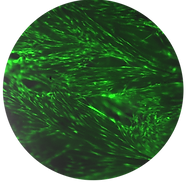
Now part of Stryker
DYNAMIC
Stability
AND
BIOLOGICAL
Restoration
Following an injury, surgical repair of the ligaments and tendons can fail to restore nature’s balance of strength and elasticity. This imbalance can lead to long recovery times, ongoing pain, loss of function, and long-term issues such as arthritis and deformity.
Artelon’s FLEXBAND® is a next-generation biomaterial specifically designed to help restore natural strength and elasticity to healing soft tissues - with the goal of getting people back to natural motion, faster and stronger.


What is it?
It is a Co-Polymer
The fibers of FLEXBAND are made from the combination of two polymers common to medical devices – polycaprolactone and polyurethane-urea. This patented co-polymer was designed for specific characteristics of strength, elasticity, and biological integration.
It is a Textile for Ligaments and tendons
These fibers are then knitted into a Dynamic Matrix® with pores specifically sized for connective tissue cells.


How Does FLEXBAND Work?
Enhanced Strength to Optimize Recovery
Surgical repair of torn ankle tissue reconnects the injured structures and reestablishes biological healing. However, these tissues are often in poor condition and repair can only do so much. Studies have shown suture repair alone may restore less than 50% of the tissue's original strength.
The FLEXBAND biomaterial has a strength similar to ankle ligaments, providing increased construct strength when added to the primary repair.
Ultimate Tensile Strength (AVG)
References:
1. Waldrop et al. Am J Sports Med. 2012 Nov; 40(11): 2590-6.
2. Data on File
Elasticity to Optimize Motion
As your foot moves, the ligaments and tendons of your ankle stretch and contract under tension to permit motion while maintaining stability. Therefore, biomaterials intended to augment the strength of this tissue also need to stretch and contract under tension. Artelon’s FLEXBAND was uniquely designed to do just that. Our novel material stretches and rebounds throughout the motion of the ankle.

FLEXBAND augmenting a soft
tissue repair in the ankle
Live cells on FLEXBAND at 9 Days



Integration with Biology
If supported, nature is a fantastic healer. FLEXBAND was purposely engineered to work with nature throughout the healing process. Our material exists quietly in the body, quickly integrating into healing tissue in the short term. Over the longer term, FLEXBAND slowly dissolves while degrading and being fully integrated into healthy new tissue in a process that takes 4-6 years. This process of integration aligns enhanced strength, elasticity for motion, and the biological restoration of the tissue to optimize recovery in both the short and long term.
FLEXBAND integrated into an ankle soft tissue at 6 months